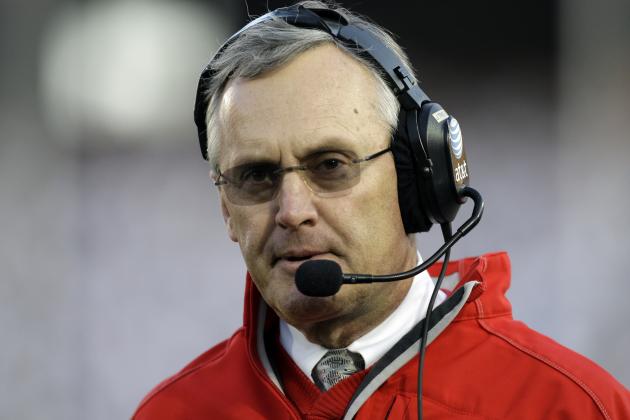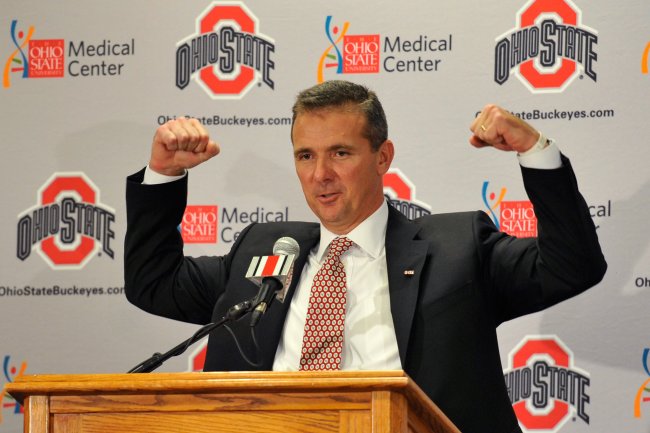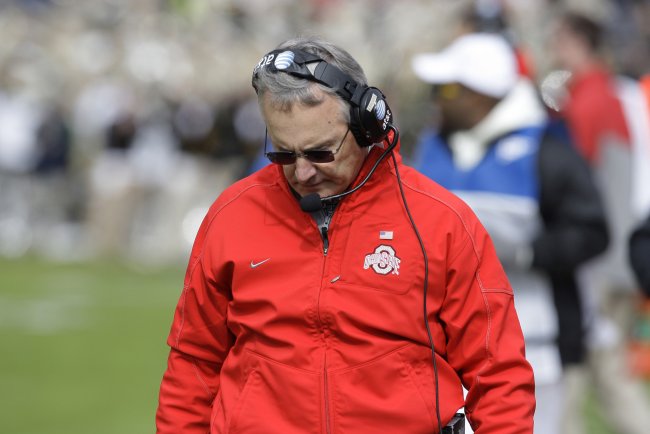
COLUMBUS, Ohio — A half-decade before Baylor dominated this past weekend’s news cycle with a barrage of firings and hirings, Ohio State was responsible for college football’s seemingly annual Memorial Day news dump.
And the five years that have followed the forced resignation of former Buckeyes head coach Jim Tressel have only brought clarity to the ramifications of the de facto firing.
Recruiting in Columbus has changed—as have on-field results—as the future of one of college football’s most prominent programs finds itself with a new trajectory moving forward. Nothing at Ohio State has been the same since Tressel’s firing—only not necessarily in the way many would have expected in late May of 2011.
As crazy as it would have sounded at the time, the Buckeyes now find themselves better off because of their program-altering Memorial Day morning five years ago.
The transformation has been quick and drastic since Ohio State fired its Hall of Fame coach. What it hasn’t been, however, is expected for a team that was engulfed in scandal and without an apparent exit strategy when it added the need for a new head coach to its growing list of problems in May 2011.
A 50-4 record, the first-ever College Football Playoff National Championship and a recruiting revolution can’t all be directly attributed to Tressel’s firing. But following a 6-7 season under interim coach Luke Fickell in 2011, Urban Meyer has ushered in a new era of Ohio State football that may not have been possible without the pains the program endured five years ago.
The math is simple: Meyer’s hiring likely doesn’t happen without Tressel’s firing in 2011, when the former Florida head coach just happened to be enjoying a short-lived retirement.
And although it’s easy to see the Buckeyes’ succession plan as a happy coincidence now, it seemed much more far-fetched at the time, mostly because of the mess Tressel helped create.

Jamie Sabau/Getty Images
Looking back now, Tatgate seems relatively harmless in comparison to more recent college controversies, including the one Baylor currently finds itself a part of. But the scandal that saw star players exchange memorabilia for cash and tattoos—and Tressel cover it up—created nearly a year’s worth of negative headlines at Ohio State, including initial suspensions, ensuing departures, additional allegations and, of course, Tressel’s departure.
By the time the Buckeyes’ first losing season since since 1988 hit its stride, the only positive in Columbus appeared to be a promising freshman quarterback named Braxton Miller, as severe punishments for the program seemed probable.
Nevertheless, Meyer took the job two days after the Buckeyes’ only loss to rival Michigan in the past 12 years and one month before a bowl ban for the 2012 season and three-year reduction in scholarships were officially put into place.
“Well, I don’t think it’s broke,” Meyer said of his new school at his introductory press conference in November 2011. “I’ve done a lot of research. I don’t think Ohio State’s broke. I think there’s some obvious mistakes made on the grand scheme of things, mistakes that are very correctable.”
The rest, as they say, is history. Despite the bowl ban, Meyer reeled off 24 consecutive wins to start his career in Columbus, led the Buckeyes to the College Football Playoff National Championship in Year 3 and has Ohio State well positioned from both a roster and recruiting standpoint heading into Year 5.
The program appeared to be drowning just five years ago, but the Buckeyes haven’t looked back since.
And while Tressel was one of Ohio State’s most successful head coaches in his own right—with a 106-22 record, including a 9-1 mark against Michigan and the 2002 national title, to his credit—this wasn’t a matter of Meyer merely getting the Buckeyes back on track. Rather, the three-time national champion head coach has since taken his program a step forward, modernizing a product that was in danger of becoming complacent following Tressel’s decade-long reign.

Darron Cummings/Associated Press
The most obvious area in which Meyer has shown improvement is on the recruiting trail, where he’s locked in five top-seven classes since arriving in Columbus and currently lays claim to the nation’s top-ranked haul in 2017. With his national approach, Meyer has strengthened Ohio State’s pipeline in Florida, forged one in Texas and become a mainstay in the emerging Eastern Seaboard.
Tressel, to his credit, was no slouch when it came to luring players to his program either, although all but one of his six classes from 2005-10 trailed Meyer’s Florida hauls in the recruiting rankings. In his first five years with the Buckeyes, Meyer has landed four top-five classes while never falling outside the nation’s top 10 in recruiting, a fate Tressel suffered in 2010.
“Prior to Urban Meyer arriving in the Big Ten, a lot of the recruiting was very basic,” Rivals national recruiting director Mike Farrell told Bleacher Report. “There was a feeling of some sort of gentlemen’s agreement where ‘We are the Big Ten, and this is the way that we recruit.'”
On the field, Tressel was still winning at the time of his departure, but there remained a sense that the Buckeyes weren’t maximizing their potential there either. After back-to-back national title losses in 2006 and 2007—the first of which came against Meyer at Florida—Ohio State failed to play in another BCS title game, with a 2009 regular-season loss to lowly Purdue marking the low point of Tressel’s on-field run.
If the Buckeyes were going to compete nationally with the SEC—which had won the past five national titles at the time of Tressel’s firing and would win two straight after it—Tressel simply may not have been the man for the job.
Meyer’s track record against his former conference since coming to Columbus, however, remains perfect thus far thanks to his victory over Alabama in the midst of Ohio State’s playoff run in 2015.
“The SEC is hot right now. And I’ve recruited against Alabama as well. They’re hot,” Meyer said at the time of his hiring. “But so is Ohio State.”

Charles Krupa/Associated Press
Only it didn’t seem that way at the time, and whether Tressel would have been capable of similar accomplishments or how his ultimate succession plan would have played out entering his second decade with the Buckeyes will never be known.
All evidence, however, points to Ohio State being in a better place now than it was five years ago, as the success the Buckeyes have enjoyed since and appear set up to sustain in the future speaks for itself.
It also may not have been possible without the groundwork Tressel laid in the first place, and Meyer has been quick to praise his predecessor, who returned to Ohio State this past spring to speak at the Buckeyes’ coaching clinic.
“Coach Tressel ran the premier program—if not the premier, one of the premier programs—in America,” Meyer said last fall.
In four short seasons, the same can also be said of Meyer’s version of the Buckeyes—and then some.
That hardly seemed fathomable five years ago, as Ohio State left a holiday weekend with no shortage of questions, unaware of just how much it would enjoy the answers.
Ben Axelrod is Bleacher Report’s Big Ten lead writer. You can follow him on Twitter @BenAxelrod. Unless noted otherwise, all quotes were obtained firsthand. Recruit rankings and info courtesy of 247Sports.
